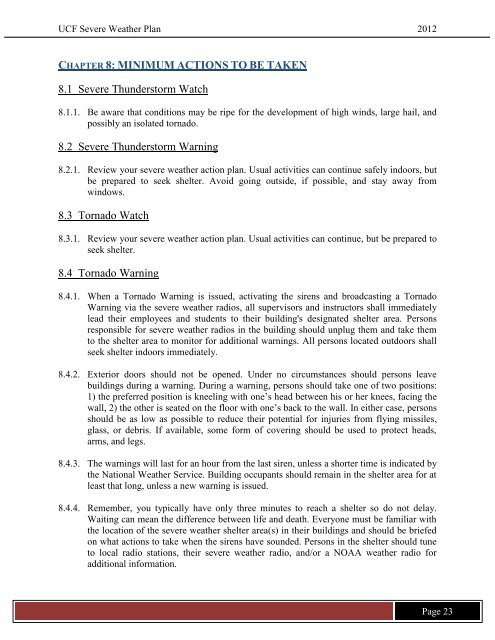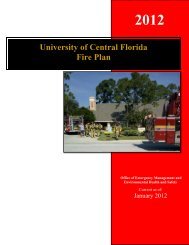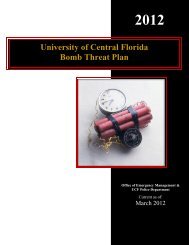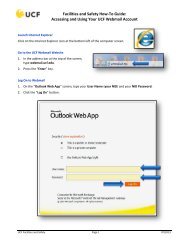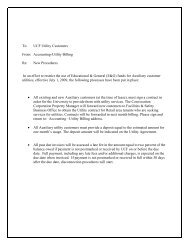University of Central Florida Severe Weather Plan - UCF Facilities ...
University of Central Florida Severe Weather Plan - UCF Facilities ...
University of Central Florida Severe Weather Plan - UCF Facilities ...
You also want an ePaper? Increase the reach of your titles
YUMPU automatically turns print PDFs into web optimized ePapers that Google loves.
<strong>UCF</strong> <strong>Severe</strong> <strong>Weather</strong> <strong>Plan</strong> 2012CHAPTER 8: MINIMUM ACTIONS TO BE TAKEN8.1 <strong>Severe</strong> Thunderstorm Watch8.1.1. Be aware that conditions may be ripe for the development <strong>of</strong> high winds, large hail, andpossibly an isolated tornado.8.2 <strong>Severe</strong> Thunderstorm Warning8.2.1. Review your severe weather action plan. Usual activities can continue safely indoors, butbe prepared to seek shelter. Avoid going outside, if possible, and stay away fromwindows.8.3 Tornado Watch8.3.1. Review your severe weather action plan. Usual activities can continue, but be prepared toseek shelter.8.4 Tornado Warning8.4.1. When a Tornado Warning is issued, activating the sirens and broadcasting a TornadoWarning via the severe weather radios, all supervisors and instructors shall immediatelylead their employees and students to their building's designated shelter area. Personsresponsible for severe weather radios in the building should unplug them and take themto the shelter area to monitor for additional warnings. All persons located outdoors shallseek shelter indoors immediately.8.4.2. Exterior doors should not be opened. Under no circumstances should persons leavebuildings during a warning. During a warning, persons should take one <strong>of</strong> two positions:1) the preferred position is kneeling with one’s head between his or her knees, facing thewall, 2) the other is seated on the floor with one’s back to the wall. In either case, personsshould be as low as possible to reduce their potential for injuries from flying missiles,glass, or debris. If available, some form <strong>of</strong> covering should be used to protect heads,arms, and legs.8.4.3. The warnings will last for an hour from the last siren, unless a shorter time is indicated bythe National <strong>Weather</strong> Service. Building occupants should remain in the shelter area for atleast that long, unless a new warning is issued.8.4.4. Remember, you typically have only three minutes to reach a shelter so do not delay.Waiting can mean the difference between life and death. Everyone must be familiar withthe location <strong>of</strong> the severe weather shelter area(s) in their buildings and should be briefedon what actions to take when the sirens have sounded. Persons in the shelter should tuneto local radio stations, their severe weather radio, and/or a NOAA weather radio foradditional information.Page 23


